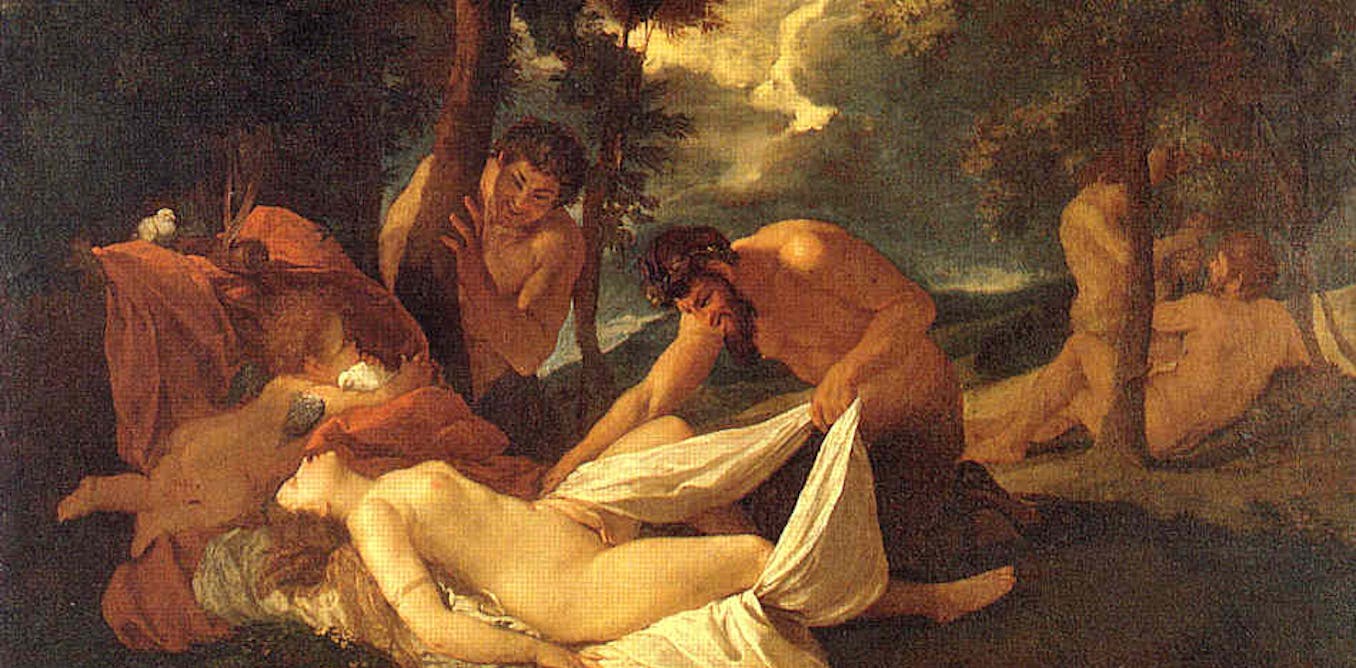The horrifying trial of mass rape in Mazan, France, has brought to light a chilling case of chemical submission, where a husband drugged his wife regularly to orchestrate her rapes. As the 51 defendants and their defence attorneys continue to deny the accusations despite overwhelming evidence, it raises important questions about the role of collective imagination in enabling sexual violence – particularly when fantasies of domination take such extreme forms.
In mythology, gods often take advantage of sleeping women. Hypnos, the god of sleep, uses his power, while Zeus seduces an unconscious Leda by transforming himself into a swan. Ariadne is abandoned by Theseus on the island of Naxos, where Dionysus falls for her beauty as she sleeps. For enchantresses like Melusine, sleep is a moment of vulnerability. Interestingly, Hypnos is the brother of Thanatos, the god of death.
In contrast, women in mythology are not allowed to invade men’s sleep. Psyche, for example, sneaks up on her sleeping husband, only to find he is Eros, the god of love. Her curiosity leads to immediate punishment, forcing her to complete a series of dangerous tasks, including a journey to the underworld to steal beauty from Persephone.
Many texts and paintings, inspired by these myths, encourage the viewer to gaze at these sleeping women through the lustful eyes of all-powerful men.
In fairy tales
In Sleeping Beauty, the princess, blessed by fairies with numerous gifts, is cursed to prick her finger on a spindle and fall into a hundred-year slumber.
The earliest version, Perceforest (15th century), and Giambattista Basile’s Italian version (1634), tell of a prince who, finding the sleeping princess attractive, takes advantage of her and fathers children while she remains unconscious. In_ Perceforest_, the prince initially hesitates, held back by “Reason” and “Discretion,” but ultimately succumbs to desire and Venus. The princess only awakens when one of her twins sucks her finger.
In Charles Perrault’s version (1697), the forest parts for the prince, and the princess wakes upon his arrival. They converse, fall in love, and have children, but the prince delays marriage. He returns home, leaving the princess to face her ogre-like mother-in-law, who orders the execution of the princess and her children. The young woman who consents does not do so without peril.
In both the Brothers Grimm version (1812) and Disney’s adaptation, the prince kisses the sleeping princess without her consent and later marries her, presented as the fulfillment of all her dreams.
According to Bruno Bettelheim’s Psychoanalysis of Fairy Tales, sleep symbolizes the time required for the formation of the adolescent soul. From a psychological perspective, being asleep represents the repression of trauma, as interpreted through a Jungian lens in works such as Clarissa Pinkola Estes’ Women Who Run with the Wolves.
But do all readers and viewers grasp the metaphorical aspects of these interpretations ? More importantly, do they recognize that forcing someone into sleep can have traumatic consequences ?
In literature
The invasion of women’s intimate spaces has long been a recurring theme in male fantasies in 17th- and 18th-century literature. In the works of Crébillon, Prévost, and Marivaux, male protagonists often fantasize about entering women’s private chambers to exploit their vulnerability while they sleep. These voyeurs are captivated by the perceived wholeness of a sleeping woman, indifferent to her own autonomy. They rationalize their actions by assuming the women were awaiting their arrival – similar to the defendants in the Mazan case, who claimed they believed it was merely part of a libertine game.
At the same time, the English novel Clarissa Harlowe by Richardson (1748), translated into French by Abbé Prévost in 1751, depicts the consequences of a drug-facilitated rape. Pursued by seducers, the beautiful Clarissa resists. Unable to tolerate her defiance, Lovelace drugs and rapes her. She ultimately dies, and her seducers come to realize the strength of female virtue. Eighteenth-century women readers praised this work for celebrating the resilience of admirable women.
By the 19th century, vampire literature, such as Bram Stoker’s Dracula (1897), portrayed vampires invading women’s bedrooms, draining their vitality with deadly bites.
In the 20th century, the theme of eroticism persists, but questions of consent become more prominent. In D.H. Lawrence’s Lady Chatterley’s Lover (1928), Mellors approaches the heroine while she is half-asleep. In Yasunari Kawabata’s The House of the Sleeping Beauties (1961), an elderly man visits a house where he can lie beside unconscious young women. Though he does not touch them, their vulnerability generates a disturbing erotic tension. In Yves Simon’s Léonore, Toujours (2000), a woman is raped in her sleep by a man she trusted, leaving him in denial and her consumed by guilt.
The fantasy of a woman being dead or asleep has captivated male authors and artists such as Bonnard and Picasso. Today, the reality of drug-facilitated sexual assault affects women in nightclubs, mothers in their own homes, and women in spaces ranging from Hollywood parties to French parliament halls.
Wikimedia
Re-examining our culture
While these images remain embedded in our culture, it is time to reevaluate them, deconstructing the “male gaze” and using counterexamples to make people think about consent.
In the age of #MeToo, many women are demonstrating that the era of silent victims is over, thanks to the courage of individuals like Gisèle Pelicot. It is crucial that this trial be held in open court to confront the defendants’ denial and challenge statements like that of the mayor of Mazan, who controversially claimed, ‘no one died’
Similarly, MP Sandrine Josso has made her complaint public and called for the creation of a commission on chemical submission, asserting that shame must change sides. In 2021, anti-sexual violence advocate Noémie Renard also urged an end to this in her work Ending Rape Culture. What can we do, culturally, to support these courageous actions ?
Revisting our classics
One way forward is to revisit our classic works through a new lens, as Jennifer Tamas suggests in her book Au NON des Femmes (2023), which adopts the perspective of female heroines. Teaching mythology and fairy tales is an important educational tool, but they must be contextualised and discussed through a contemporary lens. As Murielle Szac explains in L’Odyssée des déesses (2023), stories can highlight female resilience, reinterpreting characters like Hera and Medea as symbols of resistance rather than submission.
Reading fairy tales with children offers an important opportunity to teach consent. Educators should explain the historical context while also addressing the modern implications. Scenes in which women are unconscious or drugged should no longer be interpreted as seduction. For instance, in Dangerous Liaisons (1782), Valmont sneaks into Cécile Volanges’ room while she sleeps and violates her. This is not seduction, it is rape.
Some women have also called for an end to celebrating kisses without consent. In 2017, an English mother criticized Sleeping Beauty for its non-consensual kiss, sparking debate. In 2021, Disney’s portrayal of Snow White’s kiss in the glass coffin ignited controversy in the United States.
This doesn’t mean these works should be censored, but rather that they should be reexamined with a critical lens, as Lou Lubie does in the graphic novel Et à la fin ils meurent : La sale vérité des contes de fées (2021). Discussions about such behavior should also be encouraged, as seen in the efforts of Amnesty International and the media outlet Simone.
Embracing the “feminist gaze”
Reading more texts by women authors introduces readers to the female gaze, or what researcher Azélie Fayolle calls the “feminist gaze.” As she explains :
“We still want to read our old books and see our old films, but we no longer want to do so through the eyes of the generations that came before us ; we are of our time.”
Women authors like M.C. d’Aulnoy, known for her volumes in The Cabinet des fées), and M.J. Lhéritier, have made their mark by writing fairy tales. Comparing their versions with those of male writers highlights the agency of their heroines. In La Belle et la Bête, for example, Belle is a strong heroine created by Jeanne Marie Le Prince de Beaumont. To the Beast, who holds her captive and demands her submission, and to the handsome man who tries to seduce her, this intelligent young woman – a passionate reader – says no, taking her time to make her own decisions.
The devastating effects of rape on its victims have been described by numerous authors, including Marguerite de Navarre (L’Heptaméron, 1559), George Sand, Marguerite Duras, Annie Ernaux, and Virginie Despentes in Baise-moi (1994). These writers portray the victim’s initial shock, followed by trauma and a long “lethargic sleep.”
As we continue to awaken our collective consciousness, it is vital to remember that literature offers a path for reflection, helping women emerge from centuries of silence and slumber.



